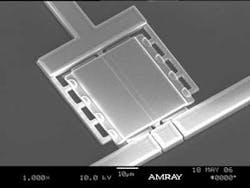The wide range of research and practical advances in photonics to be presented at this year’s Conference on Lasers and Electro-Optics/Quantum Electronics and Laser Science Conference (CLEO/QELS; Baltimore, MD, May 6-11) will be revealed in technical sessions, symposia and other talks, and on the exhibit floor. The two closely linked conferences are complemented by the Photonics Applications Systems Technologies (PhAST) conference, whose emphasis on application-ready technology balances the CLEO/QELS leaning toward basic research.
The CLEO/PhAST Plenary (Monday, May 7) will feature Nobel Prize winner Alan Heeger of the University of California at Santa Barbara discussing polymer optoelectronics; and John Ambroseo of Coherent (Santa Clara, CA) presenting a talk, “The photonics industry: enabling technology or mature market?” In addition, the winning entry of the PhAST/Laser Focus World Innovation Awards will be presented, along with four honorable mentions (the awards recognize especially innovative photonic applications, services, or products).
At the CLEO/QELS Plenary (Wednesday, May 9), William Phillips of the National Institute of Standards and Technology (Gaithersburg, MD) will speak on advances in the manipulation of atoms with light, while Sir John Pendry of Blackett Lab, Imperial College (London, England) will describe the latest developments in negative refraction in metamaterials at optical frequencies, as well as potential applications.
CLEO technical sessions
In “Laser Processing and Optical Instrumentation,” Shoji Maruo of Yokohama National University (Yokohama, Japan) will discuss micro- and nanostereolithography for production of lab-on-a-chip devices, while Rod Taylor of The National Research Council (Ottawa, Ont., Canada) will present results on femtosecond-laser nanomachining applications in fused silica. In an invited talk, Eric Mazur of Harvard University (Cambridge, MA) will talk about using femtosecond laser pulses to probe the mechanical properties of the actin network in live cells.
Mark Niece of the High Energy Laser Joint Tactical Office (Albuquerque, NM) will discuss progress on the development of high-power solid-state lasers for directed-energy applications in “Solid-State Lasers.” An invited paper given by Shawn Redmond of Northrop Grumman Space Technology (Redondo Beach, CA) will describe the development of a compact high-power near-diffraction-limited single-frequency Nd:YAG laser that emits 15 kW with a beam quality better than 1.3× diffraction-limited.
“Semiconductor Lasers” will cover electrically-pumped photonic-crystal lasers, infrared lasers using colloidal quantum dots, interband-cascade lasers, and others. Topics in “Applications of Nonlinear Optics” include energy harvesting in silicon amplifiers, lasers, and wavelength converters; nano- and microdomain engineering in KTP; and microstructured gallium arsenide for mid-IR and terahertz generation.
In “Optical Materials, Fabrication & Characterization,” researchers will present on nanofabricated negative-permeability media; feroeleectric photonic structures; biomimetic optical polymers; and directly pumped silicon lasing. Giuseppe Sansone of ULTRAS CNR-INFM Dipartimento di Fisica Politecnico di Milano (Milano, Italy) will discuss the generation of isolated attosecond pulses, with demonstrated compression of 5 fs pulses down to 130 as.
Many other CLEO technical sessions cover topics ranging from ultrafast optics, optoelectronics, and applications to medical and biological applications of photonics, including the currently very hot topic of solid-state lighting (LEDs and OLEDs).
QELS sessions
Topics in the QELS sessions focus on basic research. “Quantum Optics and Quantum Atom Optics” includes talks on laser cooling of microcantilevers, radiation-pressure effects on a micromirror in a high-finesse optical cavity, and cancellation of radiation pressure in interferometric measurements that will allow probing of the quantum effects of radiation pressure. “Quantum Information” covers all things quantum cryptographic, including single-photon sources, a space-to-Earth quantum-communications link, and spin exchange in a double-well optical lattice.
“Fundamental Optics in Periodic and Random Media” delves into leading-edge research on electromagnetic cloaking, with an invited paper given by Graeme Milton of the University of Utah (Salt Lake City, UT).
Other QELS sessions include “Ultrafast Dynamics,” “Nonlinear Optics and Novel Phenomena,” and “Nano-optics,” with a talk on a magnifying superlens in the visible frequency range by Igor Smolyaninov of the University of Maryland (Colleg Park, MD).
The PhAST conference offers several one-day symposia on subjects that include the commercialization of applied research, solid-state lighting, high-power lasers, biophotonics, and applications (jointly with CLEO), and ultrafast-laser processing and applications (also jointly with CLEO). Other PhAST events include three-day market-driven-business tracks on photonics in homeland security and lasers in manufacturing, and a networking “power lunch” with each table hosted by a photonics-industry expert. Many PhAST events are collocated with the CLEO exhibit, which is expected to accommodate more than 300 exhibiting companies.

